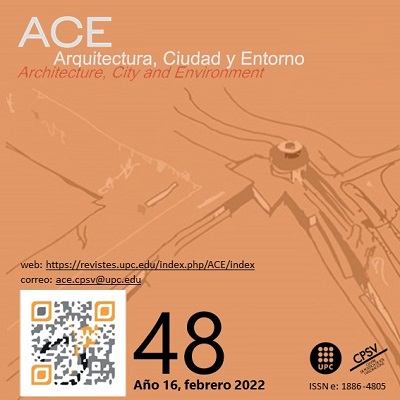Foundations of the Musical Composition of Ancient Greece. Origins of the Order and Harmony of the Urban Layout of Rhodes
DOI:
https://doi.org/10.5821/ace.16.48.10513Keywords:
Hypodamic urbanism, urban history, mathematics, musicAbstract
The hypodamic plots have been considered by renowned urban planners and historians as the origin and reference of rational urban planning, being the first to impose order and harmony in the urban fabric thanks to the systematization and relationship of its elements. They all agree in underlining mathematics as the main tool used by Hippo of Miletus in projecting his reticular tissues, however none of them delves into the investigation of a theoretical foundation that justifies the choice by Miletus of certain arithmetical proportions for the design of his layout schemes. Considering the cultural revolution which took place at the time, fueled by the Pythagorean doctrine which underlined the close relationship between the origin of mathematics and music, the present research is born that aims to demonstrate that the theoretical foundation that underlies the cities designed by Hipódamo was forged in music. And for this a detailed and parallel study is made of the rules that directed the layout of the ancient city of Rhodes and of the foundations of musical composition discovered in ancient Greece, which will show that the arithmetic proportions that achieved the "urban perfection" of Rhodes were the same that the Greeks used to define the musical scale. This leads us to affirm that the order and harmony of the hypodamic plots was achieved using as ordinances of tracing foundations of musical composition.
Downloads
Published
Issue
Section
License
| INTELECTUAL PROTECTION CRITERIA |
At this moment, it is count with the "Oficina Española de Patentes y Marcas", while global protection it is being processed by the World Intelectual Property Organization (OMPI/WIPO). Nevertheless the International Standard Serial Number Office (ISSN) has given the following numbers ISSN: 1886-4805 (electronic version) and 1887-7052 (paper version). All articles will be peer reviewed, using double blind reviewing. |
| COPYRIGHT |
The article contents and their comments are authors exclusive liability, and do not reflect necessarily the journal editor commitee's opinion. All ACE published works are subject to the following licence CC BY-NC-ND 3.0 ES http://creativecommons.org/licenses/by-nc-nd/3.0/es/ It implies that authors do not hold nor retain the copyright without restrictions but only those included in the licence. |


































